Practical tips for choosing the best beginner amphibian pets for your home aquarium, including care guide and dietary guidelines.

Introduction
Beginner amphibian pets like Axolotls, Frogs, Newts, and Toads are the ideal companions for people looking to keep rare pets. They’re low-maintenance animals due to their small size and manageable care needs.
The average beginner-friendly amphibian is hardy, making it a suitable companion for other aquarium pets, regardless of any specialized care requirements.
In this guide, you’ll see a brief overview of 7 popular beginner amphibian pets, including their unique personalities, diet types, and habitat needs. Keep reading for immediate answers and recommendations on keeping your new friends.
Do you want to watch this article instead of reading it? Checkout the highlight video below from our YouTube Channel (Or read the more detailed article below), be sure to Subscribe For More Great Fishkeeping Content:
Axolotl Care Guide for Beginners

You may know the fully aquatic Axolotl as the Mexican Walking Fish or its scientific name, Ambystoma mexicanum.
Axolotl Appearance and Features

Most wild Axolotl species have a dark color with speckles, while special breeds come in albino, golden, or leucistic colors, often featuring pink and red tones.
Author’s Note: Check out our post on the 17 Different Axolotl Colors and Their Morphs for an in-depth look at the various types of these fun oddball amphibians!
An average adult Axolotl grows up to 23cm long, but the size ranges from 15 – 45cm. This amphibian has wide eyes without lids that look like it’s smiling.
When hurt, an axolotl can regenerate its limbs, heart, spinal cord, and certain parts of its brain.
Axolotl Care Guide
Follow this axolotl beginner tank setup to give your pet the best out-of-the-wild experience. Get a tank size that’s approximately 40 gallons (150L) and set your Axolotl’s water temp between 60 – 68°F (15-20°C). The cool water is good for your pet’s sensitive skin.
Although Axolotls have regenerative abilities, it’s best to reduce the risk of skin injuries and disease by keeping a pristine water quality.
A good filtration system with moderate water flow makes lifelong aquatic care easier.
Axolotl Diet
Speaking of feeding, let’s discuss what and how to feed axolotls! As a carnivore, this pet will eat worms, insects, small fish, and commercial sinking carnivore pellets.
Following the rules in this axolotl care guide ensures your pet lives between 10 to 15 years in optimal health.
White’s Tree Frog (Australian Green Tree Frog) Care for Beginners

Now, let’s review a beginner-friendly amphibian with great handling tolerance that makes it common in the pet trade. This Ranoidea caerula, a.k.a. Australian green tree frog beginner guide, covers housing, temperament, and feeding insights.
White’s Tree Frog Appearance and Unique Features
This amphibian is chubby with big eyes and a 3 – 4.5-inch-long body. Although it’s mostly green or bluish-green in the wild, temperature changes and mood affect its color. Isn’t that interesting?
Because of their round face and big eyes, hobbyists call White’s Tree Frog the smiling frog. And during the breeding season, the males of this species produce a deeper and louder croak.
Thanks to their docile nature, white’s tree frogs allow for frequent handling, allowing owners to caress their waxy skin.
Now, let’s discuss the ideal White’s tree frog tank setup.
White’s Tree Frog Care Guide
Get a 15–20 gallon vertical terrarium with a climbing ramp because this species is not fully aquatic. Set the terrarium’s humidity to 60 – 70% and a temperature of 75 – 85°F during the day for warmth.
White’s Tree Frog Diet
If you’re wondering about how to feed White’s tree frog, here’s your answer. It’s a carnivore that eats live insects like crickets, worms, small roaches, and commercial mealworms.
Now that we’ve covered White’s tree frog care, let’s move to the next frog on our list of beginner amphibian pets.
American Green Tree Frog Care Guide

No. 3 on our list is the American Green Tree Frog, scientifically known as Hyla cinerea, but now classified as Dryophytes cinereus. It’s a small but vibrant amphibian native to Southeastern America.
American Green Tree Frog Appearance and Traits
The American Green Tree Frog is a vibrant green amphibian with yellow or white stripes that stand out on its body, measuring 1.25 to 2.5 inches. This species is nocturnal and loves feeding on live prey. It’s aggressive, especially when handled, so minimize handling during American green tree frog care routines.
American Green Tree Frog typically lives for 5-6 years or 10 years with proper care! These few Hyla cinerea beginner care tips are simple to follow but effective.
American Green Tree Frog Care Guide
An ideal American green tree frog tank setup should mimic its natural habitat, which are marshy wetlands.
Get a small, vertical tank that holds at least 10 gallons of water, designed as a terrarium, and maintain moderate humidity between 50% and 70%.
Use spring or dechlorinated water for the aquarium and set two temperature ranges.
| Daytime | 70-80°F |
| Nighttime | 65-72°F |
American Green Tree Frog Diet
Let’s review the American green tree frog’s feeding habits. As a small yet active species, this amphibian eats mostly insects like crickets, tiny roaches, flies, and moths, with fruits as supplements.
Pacman Frog (Horned Frog) Beginner Care
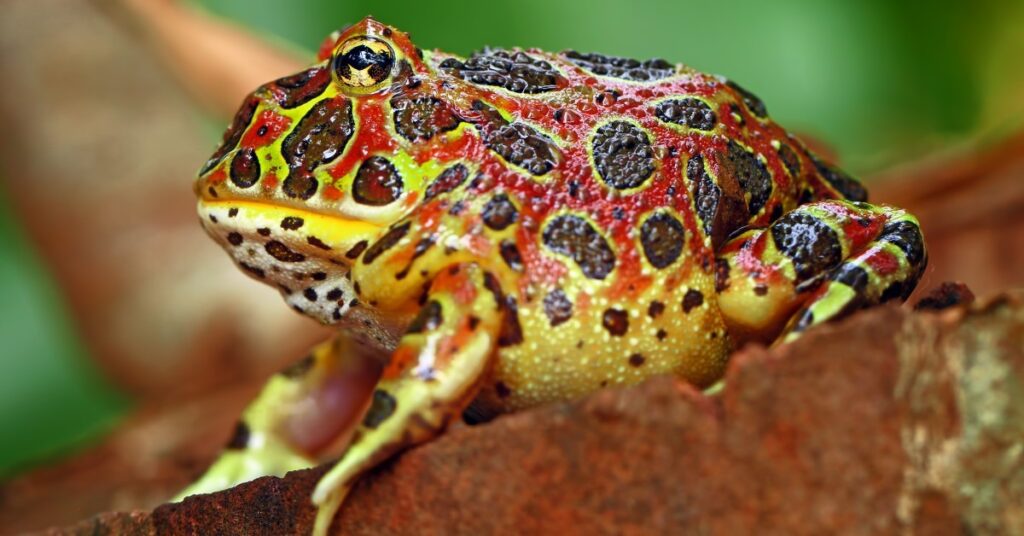
One of the most popular beginner amphibian pets amongst hobbyists is the Pacman (Horned) Frog, Ceratophrys ornata.
We’ll start this Pacman frog care guide with an overview of its characteristics.
Pacman Frog Appearance and Traits
If you haven’t guessed already, its name comes from the famous video game character Pac-Man because of its wide mouth. The Pacman Frog also has the following features:
- A body length of approximately 4-7 in (10-18 cm)
- Multiple color variants ranging from dull brown to green, albino, fantasy morphs and strawberries.
- A round body and short limbs
- A solitary and aggressive personality that makes them sit-and-wait predators.
Pacman Frog Care Needs
Horned frog care includes recreating its natural habitat, adequate feeding, health care and daily maintenance.
A proper Pacman frog beginner tank should be horizontal and contain at least 10 -20 gallons of water. It requires a moist substrate as a ground-dwelling pet that benefits from occasional heat. So set the following parameters:
| Humidity | 60-80% |
| Day Temperature | 75-85°F |
| Night Temperature | 70-75°F |
| Lighting | Regular UVB |
Pacman Frog Dietary Needs
Ensure minimal handling when feeding Pacman frog pets because they are aggressive eaters. Feed them carnivorous food, especially insects, smaller frogs, small reptiles, rodents, and commercial mealworms.
Tomato Frog Care Basics
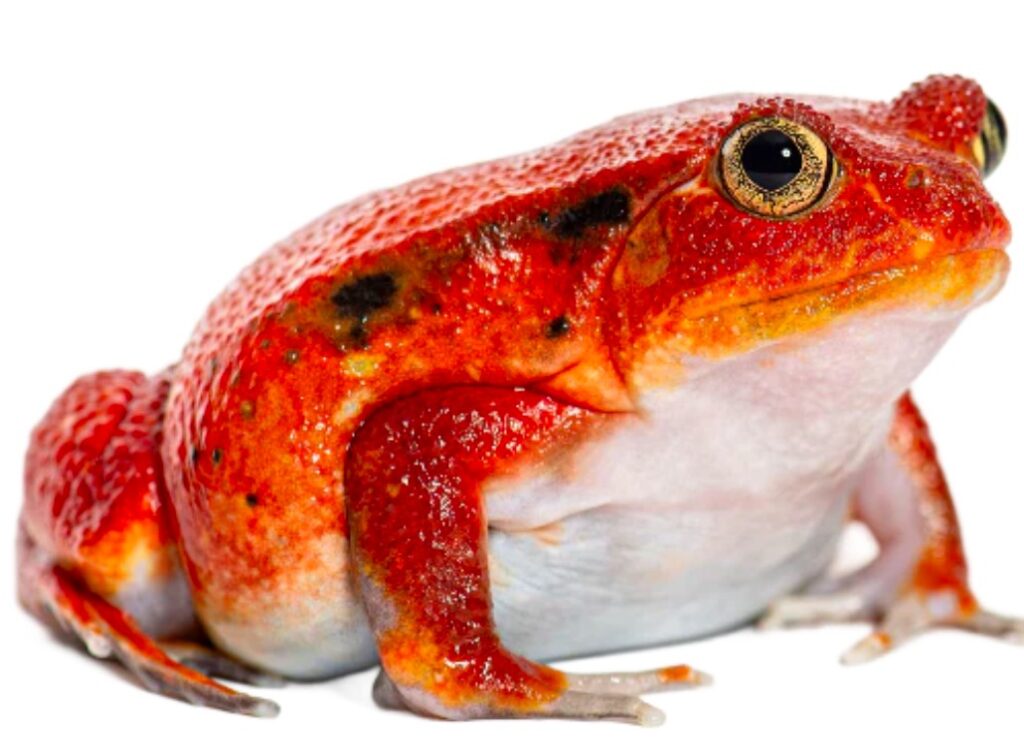
Dyscophus spp. a.k.a. Tomato Frog is a compact-sized pet that needs a burrow-friendly substrate. Understanding this species’ characteristics and dietary needs will help provide adequate Tomato frog care.
Tomato Frog Appearance and Traits
Although the Tomato Frog has a bright coloration and a tiny body, it secretes sticky substances as a defense against predators.
Over time, because of its 2.5-4 inches size and colorful tomato-like appearance, the Tomato Frog became an exotic amphibian pet. The females are reddish-orange, while the males are dull yellow. Tomato Frogs’ temperament is nocturnal and reclusive, so you’d rarely see them in the open unless you create the right Tomato Frog tank setup.
Tomato Frog Care Needs
Use this Tomato Frog beginner guide to build a small enclosure with optimal conditions for your pet. It’ll maximize its lifespan from 6-8 years to 10 years. Use these parameters:
- Tank Size: 10-20 gallons
- Humidity: 60 – 80%
- Temperature: 72 – 80°F
- Substrates: Moist soil mix, Sphagnum Moss, or Moist Coco Fiber.
Tomato Frog Diet
Use live worms or crickets with small invertebrates and other insects for tomato frog feeding. If you handle this species during feeding, don’t rub your eyes afterward! The mucus on their bodies causes allergic reactions.
Fire-Belly Newt Care Guide

This Japanese and Chinese Fire Belly Newt beginner guide will help you build a proper semi-aquatic setup for this mildly toxic pet. Although both species are hardy, they’re easy to maintain in aquariums.
Let’s start with a brief introduction to their traits.
Fire-Belly Newt Appearance and Traits
The Fire-Bellied Newt got its name from its vibrant orange and red underbelly, which is a beautiful yet protective characteristic. However, their top bodies are either brown or black, depending on the species and selective breeding results.
Predators stay away because they see the color as a sign of toxicity. It helps them because this species moves slowly.
Fire Belly Newts grow between 3-5 inches and live longer than other amphibian species, with a lifespan of 10 – 15 years.
Fire-Belly Newt Care Guide
As active swimmers with a preference for cold water, your Fire Belly Newt tank setup should consist of the following:
- Land/water mix
- Cool temps between 62-68°F
- low-flow filter
Fire-Belly Newt Diet
Although this species is diurnal, nocturnal feeding for a Fire Belly Newt is the best. Avoid handling while feeding them bloodworms, small insects, aquatic invertebrates, and commercial sinking carnivore pellets.
Oriental Fire-Bellied Toad Beginner Care

This Oriental Fire-Bellied Toad, or Bombina orientalis care guide, contains tips on proper housing to manage its unique features and feeding habits.
Oriental Fire-Bellied Toad Appearance and Traits
You can only provide proper oriental fire-bellied toad care when you understand its characteristics.
It has bright warning colors on the underbelly, similar to the Fire-Bellied Toads, but with a bumpy dorsal back in green/black.
Despite being small, Oriental Fire-Bellied Toads are semi-toxic and social if housed right.
Oriental Fire-Bellied Toad Care Guide
For your ideal fire-bellied toad tank setup, provide minimal lighting in a vivarium enclosure and prepare for mild toxin exposure.
Set a daytime temperature of 68-75°F and a nighttime temperature of 60-68°F in slow-moving waters similar to the ponds in its natural habitat.
Oriental Fire-Bellied Toad Feeding
With proper fire-bellied toads feeding on rich carnivorous foods like aquatic invertebrates, worms and insects, and commercial mealworms, they’d live an average of 10-15 years.
Bonus Section – Beginner Amphibian Enclosure Essentials
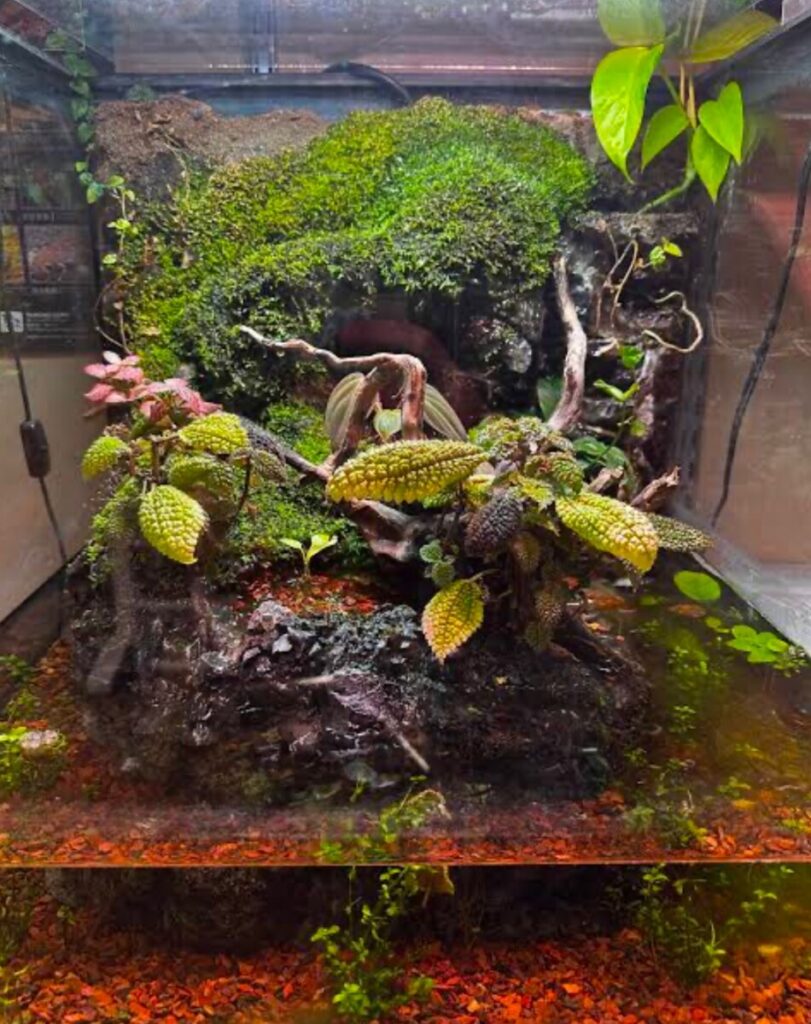
That’s the end of our top 7 beginner amphibian pets list, but before closing this guide, here are some amphibian habitat tips. They include recommendations on choosing the ideal beginner amphibian enclosure setup and maintenance procedures.
Amphibian Tank Essentials
These amphibian tank essentials in your setup provide your pets with the best possible life and are suitable for cross-species compatibility.
- Heating: Ceramic or side-mounted heaters work for aquarium setups in cold rooms.
- Humidity: 50-80% is the average humid range for all amphibians.
- Substrate: Choose your substrate based on your pet’s behavior. Use burrow-friendly substrates like coconut fiber for Frogs and Toads, Sphagnum moss for Tropical pets, and fine sand/smooth gravel for fully aquatic setups.
- Filter: Filter types depend on your pet’s size. Use low to moderate filters for tiny amphibians, while large amphibians with strong limbs can survive in heavy currents.
Feeding Schedules
Most amphibians are nocturnal, so night feeding is best for them. However, you can also research your pet’s preference before making a schedule.
Handling Guidelines
Don’t handle aggressive and toxic amphibians. If you don’t know your pet’s status, it’s best to avoid handling it. But if it’s a non-toxic amphibian that tolerates handling like the White Tree Frog, go ahead.
Avoid touching your eyes after handling your pets.
Common Care Themes
- Water Dechlorination: Remove chlorine from your tank water or use only spring and tap water.
- Humidity Control: Set regulated humidity levels.
- UVB Optionality: Use regular UVB lighting for a day/night cycle, but note special lighting types for sensitive amphibians.
Conclusion: Which Amphibian Suits Your Lifestyle?
When choosing beginner amphibian pets, you must consider the following:
- Time
- Space
- Handling desire
- Aesthetic
Can you make time for maintenance? Where would you mount your setup? Do you want an amphibian you can handle? How would the pet look in your space? Once you answer these questions, you’re ready.
You can choose any of the seven easy pet frogs or newts listed in this guide, especially if they’re captive-bred.
If you’re struggling to choose, make an amphibian pet comparison list using the following metrics:
Care difficulty vs temperament vs. handling vs. tank size. It’s a foolproof system. Try it, and let’s hear your thoughts in the comment section.


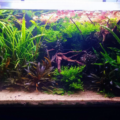
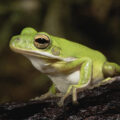
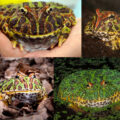
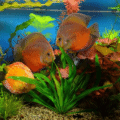
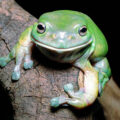
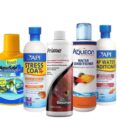
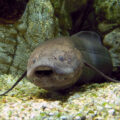
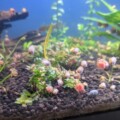

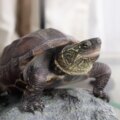
3 thoughts on “7 Beginner-Friendly Amphibians: Complete Care Guides for First-Time Owners”